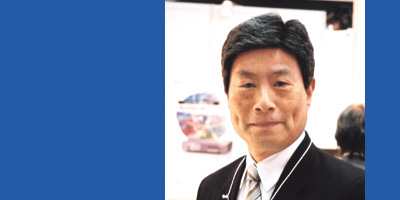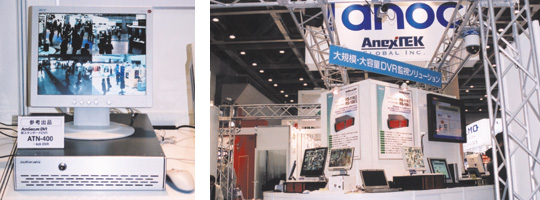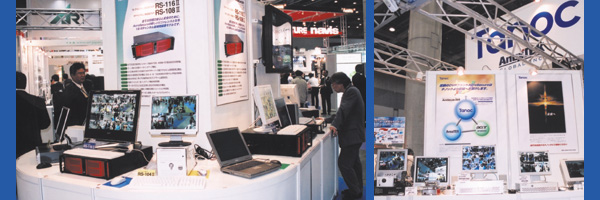Tanoc -- Keeping the Bad Guys Out
Back to Contents of Issue: June 2005
|
|
||||
|
by John Dodd |
||||
The cohesion of Japanese society is starting to break down as its demographics change. The increasing demands of a competitive work and school environment are starting to take their toll on kids and parents alike. Almost daily there are cases of bus hijackings, home and school invasions, burglaries, phone extortion of old folks and pillaging of their bank accounts, and a million other miseries that can be visited by one human being on another. Although Japan's crime rate is still much lower than that of other developed countries -- for example, the homicide rate in 2002 was just 1/20 of that in the USA -- robbery, auto theft, and burglary have jumped by 105 percent, 75 percent, and 48 percent, respectively, in the last five years. Fanned by sensationalist reporting, the jump in crime has created a siege mentality, with kids being chaperoned and electronically monitored, and communities installing camera systems in shopping streets. Against this background, it is no wonder that the Japanese home and office security industry is undergoing a revolution. Leading companies have grown into billion-dollar behemoths -- with the top player, Secom, expecting to post JPY553.8BN (US$5.3BN) in group sales in fiscal 2004 (ending March 2005), a 5 percent rise from the previous year. As of the end of September 2004, they had 610,000 security contracts with corporate clients and in the hot new home sector, around 300,000 clients, up 8 percent from a year before. Then there is upstart rival, Sohgo Security Services, which although not making as much profit, has cut the cost of home security solutions by 50 percent, to around JPY2,000 per month. As a result, they are now delivering an unprecedented 3,000 plus new systems to homes around Japan every month, and will soon hit an installed base of 70,000 homes. Now that both companies are busy duking it out, squaring off feature-for-feature, they are obliged to not only deliver reasonable costs, but also quality features as well. Unfortunately, if you've ever seen those crime scene videos on the TV news, most surveillance systems provide a grainy image of the perpetrator, and you have to wonder how the police can ever utilize those fuzzy images as substantial proof in a court of law. Catching Criminals In fact, the open secret is that the low quality of many surveillance systems means that a lot of crimes don't get solved quickly from visual evidence; the features of people captured by cameras are often indistinguishable and the standard 1-frame-per-second video capture rate can miss much fast motion. The poor performance of surveillance equipment came to light in a very public way in December 2004, when an arsonist began a series of sometimes deadly attacks against the discount store chain Don Quixote. Although security people caught a fleeting image of the suspect on camera, the image was not clear enough to be of use. A few days later the arsonist struck a second time. Staff noted the license plate of a woman who fled the scene. Police later identified her from DNA extracted from saliva on a cigarette butt found at the scene. But for that lucky break, the arsonist might still have been at large. Stand-out Solutions Clearly, then, as the Japanese public becomes more sensitized to the need for personal security, the quality of the security infrastructure and systems is also becoming an issue. One start-up company based in Asakusa, Tokyo, Tanoc Inc., has interpreted the trends well, and is producing high-quality video capture servers for use in the home and office. Business is good for Tanoc, and in the last three years the firm has become one of the fastest growing security equipment and systems vendors in Japan. Tanoc's underlying technology is the key to the firm's success. It represents the Japanese arm of two core technologies which prove that seeing is believing. First, it uses an advanced variant of MP4, called AcroSecure, to store the video. Not only does this provide noticeably better image quality for a given lens, but it also compresses better into smaller archive files. Second, Tanoc has built systems with very small footprints to manage and archive a large number of cameras all at the same time. Thus the company's technology is finding its way into some large installations in banks, hospitals, and campuses around Japan. Coupled with the power of its mini server units, Tanoc has also created massive storage capabilities, which in the case of one unit allow up to 7 months of continuous footage at 5 frames per second (5fps) from 16 cameras to be stored internally without any archiving! Tanoc Inc. was started by CEO Takeshi Seoka, in July, 1999. Seoka, originally a manager with Oki Denki, decided that in the last decade of his working career he should try to create something a bit more substantive for himself than just a simple pat on the back and a parting handshake upon retirement. Initially, he tried to create his own product range, but he soon realized that he was more suited to marketing and sales than technology development. As luck would have it, he attended an office/home security show in late 2002, and realized that there was potential in helping to protect your loved ones.
Thus he set about finding a partner and soon picked up on the hot technology of AnexTEK Global Inc., a company based in Taiwan and a subsidiary of the Wistron group. His choice of partners turned out to be a fortuitous match, and the two companies and their CEOs got along right away. In the first year of operations, Tanoc had modest revenues of JPY34MM -- just enough to keep AnexTEK away from other suitors. Then in FY2003, sales jumped dramatically to JPY224MM, and this year are estimated to reach JPY520MM. That's a pretty dramatic rise in just three short years. Seoka reckons he can keep the 100% growth rate up for another two years, meaning that he'll be ready for an IPO by 2007. While you might think that cheaper home systems are the order of the day, in fact, almost all of Tanoc's revenue is coming from the company's more advanced products, some of which sell for more than JPY2MM each. It appears that within a certain acceptable pricing band, customers don't want to skimp on the level and quality of security in their homes and offices. Tanoc's happy existence is based on the fact that you can SEE the difference between its products and the many others out in the market. We were shown screens running 16 or more separate camera images -- typically one per camera, so you can connect plenty of them -- all etched out in breathtaking quality and clarity, and with no delay in rendering. Tanoc Meets Japan's Largest Vendor of Security Systems The Tanoc solution quality stands out for clients as well, and sales are rocketing upwards. By the end of 2004, Seoka was able to snare the most desirable trophy contract in his industry, an agreement to supply high-end systems to Japan's largest security systems vendor. How Tanoc came to the attention of this vendor is a classic example of the notion that quality sells. After releasing their first system, Tanoc started demonstrating it to banks in Kyushu. Within a couple of months, they were asked to join a competitive bid for the office security business of S-Bank. This vendor was the incumbent and were certain that their size and standing would win them the contract. They were reportedly dumbfounded to learn that a start-up was named as the winner and soon started making enquiries as to how Tanoc pulled it off. They discovered that S-Bank chose not on price, but on the viewability of Tanoc system images -- along with the long-term recording system. The Kyushu regional manager of the security vendor realized that Tanoc was going to be hard to beat, at least for the two to three years it would take for their own company to develop a competitive system, and decided to recommend to head office that they become an authorized partner with Tanoc in Kyushu. Demonstrations were arranged and the head office directors were reportedly so impressed by the quality of the images, they immediately understood the value of being able to actually identify facial features versus trying to pick out the color of clothing on an indistinguishable blob rendered by competing products. They then invited Tanoc to submit equipment for testing at their R&D center, and put Tanoc on a fast track for approval -- which happened six months later. Fast forward 12 months, and as of the first quarter of 2005, Tanoc was supplying the industly giant with 100 - 200 video surveillance servers per month, with a healthy order backlog of several months. As a partner, Tanoc's business in Kyushu has rapidly expanded, and now includes such key clients as provincial banks, and medical institutions. Many of these high-level systems are being used to help reduce bankcard fraud at ATMs. In Japan in the first three months of 2005 alone, there were over 30 cases of withdrawals on fake or illicitly procured bankcards involving amounts averaging JPY1MM (US$9,500) each. In March 2005, in response to public concerns and the apparent inability of banks to do anything about it, the banking industry agreed in principal to make qualified restitution to the victims of bankcard fraud. Clearly then, the banks now have an incentive to catch criminals in the act. But as good as the equipment is, probably the clincher in winning a partnership with Japan's largest security vendor was when Seoka disclosed that even as a small company, he already had a full nationwide user support network -- offering support at very reasonable prices. How he was able to achieve this with only eight employees is an indication of why Japan's older entrepreneurs can often do a lot better than their younger counterparts. In fact, Seoka was able to secure a deal through an ex-colleague with the service subsidiary of his old employer, Oki, to support both his recorders and also train/support users in 300 locations. The Oki pricing was very reasonable, and will be adjustable once the support contract is in place and actual customer interest levels reviewed. Coming prepared with a nationwide service organization to customers has significantly reduced the risk of taking on Tanoc solutions. A typical Tanoc high-end product is the RecA Jr Digital Video Recorder (DVR), which can record data from up to 16 cameras on a 7x24 basis, with the need for archiving only once every six months. This feat of longevity is achieved with the help of special image data compression, a 5 frames-per-second video capture strategy, and 8 x 250GB hard disks set up as a 2.4TB disk array on the video capture server. This kind of performance is about four times better than comparable products in the JPY2m-3m price range and is making converts of both private and public organizations alike. The primary target for this kind of high-end product is financial institutions -- for both ATMs and trading rooms, as well as hospitals and other local government facilities. Fabless Production But while business appears to be growing in leaps and bounds for Tanoc, there is a possible downside to the story -- namely, that the company does not possess its own technology. We pointed this out to Seoka, and he agrees that on the surface, this is a weak point. However, he says that his strategy is NOT to build a lot of infrastructure, but to stay focused on sales. He wants to become a fabless operation, with design and development subcontracted out to other vendors. This business model is already working, and his technical development arm is AnexTEK in Taiwan. In the future, Seoka hopes to have his own complementary R&D team right here in Tokyo. Over the next three to five years, expect Tanoc to rise up as a trading company of sorts, but one focused on a specific area of expertise: that of combining security systems with IP and multimedia. The difference to most trading houses will be that Seoka has in-house expertise and thus the ability to directly drive the specifications of products made by a manufacturing partner. In this sense, it may happen that Tanoc becomes a hybrid solution, lying somewhere between network equipment seller/maker Allied Telesis and specialty solutions reseller Dodwell. As the company diversifies its portfolio beyond the highly reliable and repeatable AnexTEK business, time will tell if this is a viable strategy or not. In the meantime, the value Tanoc adds in the AnexTEK relationship is its ability to come up with new applications for the technology. Tanoc is the only partner of AnexTEK Ltd. in Japan, and is planning a range of new products suitable for Japan and thereafter overseas. For example, Tanoc asked AnexTEK to create a variation of the basic system, to sell to marketing companies wanting to monitor pedestrian traffic past clients' store premises. This monitoring is a common activity in Japan and usually achieved by hiring two or three university students, who sit at a location all day clicking counters for each person passing by, plus of course a project manager. This means that the labor cost alone for a single location can be as much as \200,000 -- and there is very little intelligence to be gained from such data. Tanoc's solution is to record the location wirelessly, then view the images on multiple screens at three to four times the normal speed. In the near future, visual search engines will eliminate the need for human viewing of the recordings at all.
Pachinko Connection In Japan, security surveillance cameras can show up in the most interesting places and for the most interesting purposes. One of these is to monitor machine tampering in pachinko (Japanese pinball) parlors. Just as Las Vegas casino operators are looking for card cheats and roulette wheel tampering, the pachinko operators are looking for scamsters trying to manipulate machines to increase payouts. While at Tanoc, we were shown a video of a customer playing a pachinko machine, and who was suspiciously tapping his fingers on the front of his machine with a regular beat. It turns out that the guy was wearing an electrical pulsing unit which is usually used for weight loss or relaxation, but in this case was wrapped around his wrist and turned up to full power. He was synching the rhythmic wrist twitching caused by the unit pulses with the machine tumbler rhythms, in order to win jackpots up to one every half hour -- about ten times more than normal! Since Pachinko halls tend to attract certain personality types, the operators need to keep a close eye on things -- especially those customers wired up with a robot-like prosthesis. The Tanoc solutions let them do that -- offering image clarity, reasonable speed (5 fps or 30 fps), and months worth of non-stop recording as evidence, just in case police inter-vention is required. Foreign Relationships Seoka sees his company as becoming THE source in Japan of know how and technology for security imaging sys-tems. As such, he believes foreign customers and vendors/partners will play a key role in his future plans. Already he has regular contact and strategy sessions with AnexTEK, and is supplying the engineers there with new ideas specific to the Japan market for additional functionality and features. Then there are foreign customers. Seoka reasons that with all the M&A and real estate procurement going on through foreign firms in Tokyo these days, the need by such clients for better security systems is going to increase -- and he wants a piece of that action. To make sure that he can deal with Western-style enquiries, he has already hired several English-speaking sales staff and is canvassing the larger investment firms for interest. Seoka is also interested in representing in Japan those new foreign security products with a strong built-in intellectual property component. Patented technology and/or global trademarks both rank highly in his list of preferences. While he may take a while to test-drive samples, with the level of contacts and experience Tanoc is developing these days, foreign firms wanting to get into Japan will be dealing direct with the horse's mouth, not the other end, in getting feedback about whether their products will make it in Japan. JI ***** Contact details : Tanoc Limited CEO : Takeshi Seoka English Sales Team Leader : Masaaki Yamada Address : MJ Building, 2-17-7, Kuramae, Taito-ku, Tokyo,111-0051, Japan Web : www.tanoc.co.jp Email : e-sales@tanoc.co.jp |
||||
Note: The function "email this page" is currently not supported for this page.








